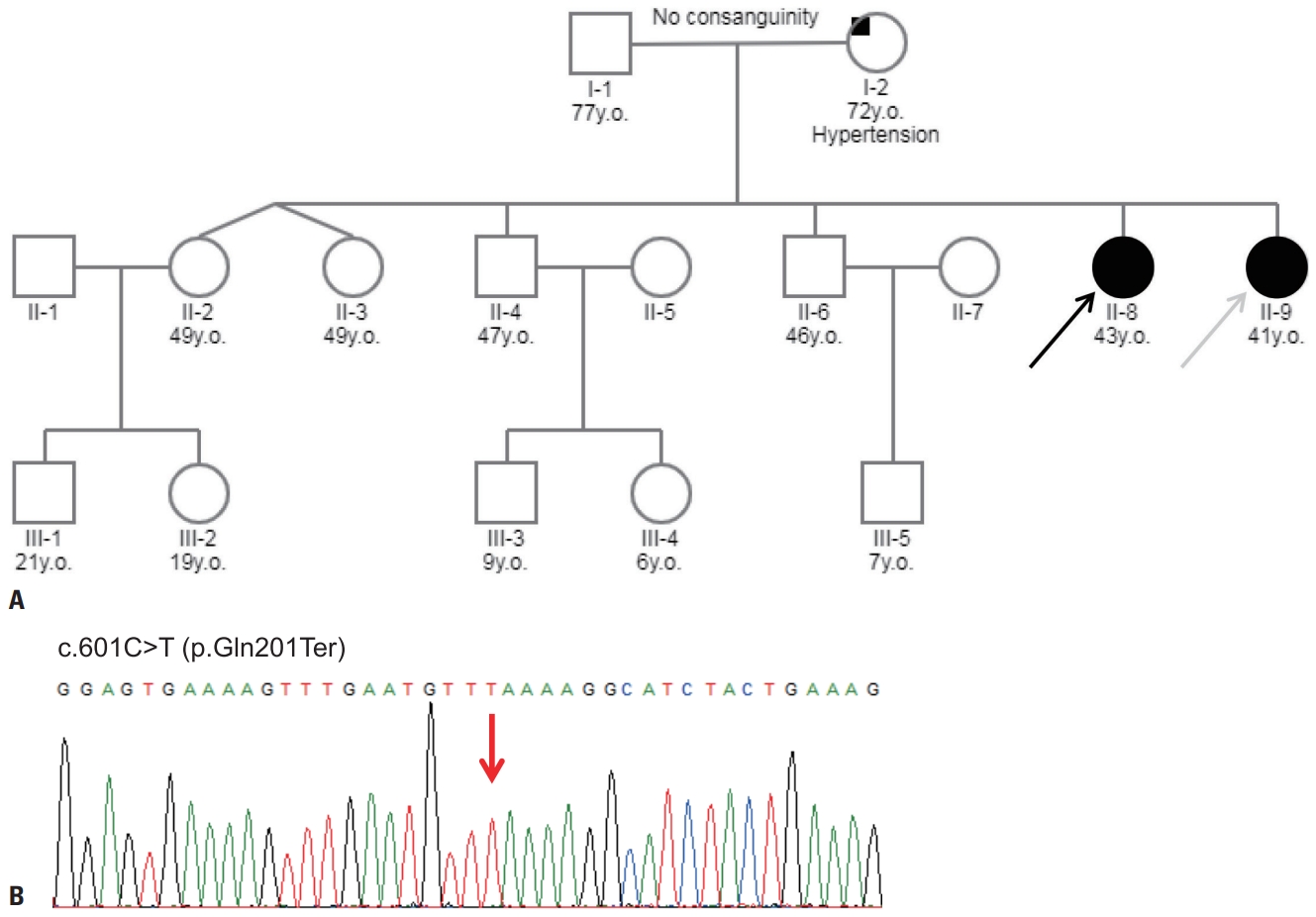Ann Clin Neurophysiol.
2020 Apr;22(1):29-32. 10.14253/acn.2020.22.1.29.
LGMD2E with a novel nonsense variantin SGCB gene: a case of LGMD2E with anovel variant
- Affiliations
-
- 1Department of Neurology, Gangnam Severance Hospital, Yonsei University College of Medicine, Seoul, Korea
- KMID: 2500301
- DOI: http://doi.org/10.14253/acn.2020.22.1.29
Abstract
- Sarcoglycanopathies are a rare group of autosomal recessive limb-girdle muscular dystrophies (LGMDs) caused by genetic variants in α-, β-, γ-, or δ-sarcoglycan that maintain membrane integrity and contribute to molecular signal processing. High-throughput nucleotide sequencing was performed in patients with slowly progressive proximal muscle weakness from early childhood with respiratory involvement, which detected a novel homozygous nonsense variant (c.601C>T;p.Gln201Ter) in SGCB. This report informs about the clinical characteristics of LGMD2E (type-2E LGMD) in Korea and provides genetic confirmation of the disease.
Figure
Reference
-
1. Ozawa E, Mizuno Y, Hagiwara Y, Sasaoka T, Yoshida M. Molecular and cell biology of the sarcoglycan complex. Muscle Nerve. 2005; 32:563–576.
Article2. Moore SA, Shilling CJ, Westra S, Wall C, Wicklund MP, Stolle C, et al. Limb-girdle muscular dystrophy in the United States. J Neuropathol Exp Neurol. 2006; 65:995–1003.
Article3. Rosales XQ, Tsao CY. Childhood onset of limb-girdle muscular dystrophy. Pediatr Neurol. 2012; 46:13–23.
Article4. Park HJ, Jang H, Kim JH, Lee JH, Shin HY, Kim SM, et al. Discovery of pathogenic variants in a large Korean cohort of inherited muscular disorders. Clin Genet. 2017; 91:403–410.
Article5. Semplicini C, Vissing J, Dahlqvist JR, Stojkovic T, Bello L, Witting N, et al. Clinical and genetic spectrum in limb-girdle muscular dystrophy type 2E. Neurology. 2015; 84:1772–1781.
Article6. Bönnemann CG, Wong J, Ben Hamida C, Hamida MB, Hentati F, Kunkel LM. LGMD 2E in Tunisia is caused by a homozygous missense variant in beta-sarcoglycan exon 3. Neuromuscul Disord. 1998; 8:193–197.7. Bönnemann CG, Passos-Bueno MR, McNally EM, Vainzof M, de Sá Moreira E, Marie SK, et al. Genomic screening for beta-sarcoglycan gene mutations: missense mutations may cause severe limb-girdle muscular dystrophy type 2E (LGMD 2E). Hum Mol Genet. 1996; 5:1953–1961.8. Khadilkar SV, Singh RK, Hegde M, Urtizberea A, Love DR, Chong B. Spectrum of variants in sarcoglycan genes in the Mumbai region of western India: high prevalence of 525del T. Neurol India. 2009; 57:406.9. Moreira E, Vainzof M, Suzuki OT, Pavanello RC, Zatz M, Passos-Bueno MR. Genotype-phenotype correlations in 35 Brazilian families with sarcoglycanopathies including the description of three novel variants. J Med Genet. 2003; 40:e12.10. Xie Z, Hou Y, Yu M, Liu Y, Fan Y, Zhang W, et al. Clinical and genetic spectrum of sarcoglycanopathies in a large cohort of Chinese patients. Orphanet J Rare Dis. 2019; 14:43.
Article
- Full Text Links
- Actions
-
Cited
- CITED
-
- Close
- Share
- Similar articles
-
- A Case of Hailey-Hailey Disease with a Novel Nonsense Mutation in the ATP2C1 Gene
- New Nonsense Variant c.2983G>T; p.Glu995* in the CACNA1A Gene Causes Progressive Autosomal Dominant Ataxia
- A nonsense PAX6 mutation in a family with congenital aniridia
- A novel de novo mosaic mutation in PHEX in a Korean patient with hypophosphatemic rickets
- A Novel MUT Gene Mutation Detected in a Female Infant with Methylmalonic Acidemia


